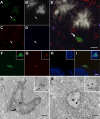Invasion of hematopoietic cells into the brain of amyloid precursor protein transgenic mice
- PMID: 16319312
- PMCID: PMC6725647
- DOI: 10.1523/JNEUROSCI.2545-05.2005
Invasion of hematopoietic cells into the brain of amyloid precursor protein transgenic mice
Abstract
The significance of the peripheral immune system in Alzheimer's disease pathogenesis remains controversial. To study the CNS invasion of hematopoietic cells in the course of cerebral amyloidosis, we used a green fluorescence protein (GFP)-bone marrow chimeric amyloid precursor protein transgenic mouse model (APP23 mice). No difference in the number of GFP-positive invading cells was observed between young APP23 mice and nontransgenic control mice. In contrast, in aged, amyloid-depositing APP23 mice, a significant increase in the number of invading ameboid-like GFP-positive cells was found compared with age-matched nontransgenic control mice. Interestingly, independent of the time after transplantation, only a subpopulation of amyloid deposits was surrounded by invading cells. This suggests that not all amyloid plaques are a target for invading cells or, alternatively, all amyloid plaques attract invading cells but only for a limited time, possibly at an early stage of plaque evolution. Immunological and ultrastructural phenotyping revealed that macrophages and T-cells accounted for a significant portion of these ameboid-like invading cells. Macrophages did not show evidence of amyloid phagocytosis at the electron microscopic level, and no obvious signs for T-cell-mediated inflammation or neurodegeneration were observed. The observation that hematopoietic cells invade the brain in response to cerebral amyloidosis may hold an unrecognized therapeutic potential.
Figures




References
-
- Akiyama H, Barger S, Barnum S, Bradt B, Bauer J, Cole GM, Cooper NR, Eikelenboom P, Emmerling M, Fiebich BL, Finch CE, Frautschy S, Griffin WS, Hampel H, Hull M, Landreth G, Lue L, Mrak R, Mackenzie IR, McGeer PL, et al. (2000) Inflammation and Alzheimer's disease. Neurobiol Aging 21: 383-421. - PMC - PubMed
-
- Austyn JM, Gordon S (1981) A monoclonal antibody directed specifically against the mouse macrophage. Eur J Immunol 10: 805-815. - PubMed
-
- Calhoun ME, Burgermeister P, Phinney AL, Stalder M, Tolnay M, Wiederhold KH, Abramowski D, Sturchler-Pierrat C, Sommer B, Staufenbiel M, Jucker M (1999) Neuronal overexpression of mutant amyloid precursor protein results in prominent deposition of cerebrovascular amyloid. Proc Natl Acad Sci USA 96: 14088-14093. - PMC - PubMed
Publication types
MeSH terms
Substances
LinkOut - more resources
Full Text Sources
Other Literature Sources
Medical
